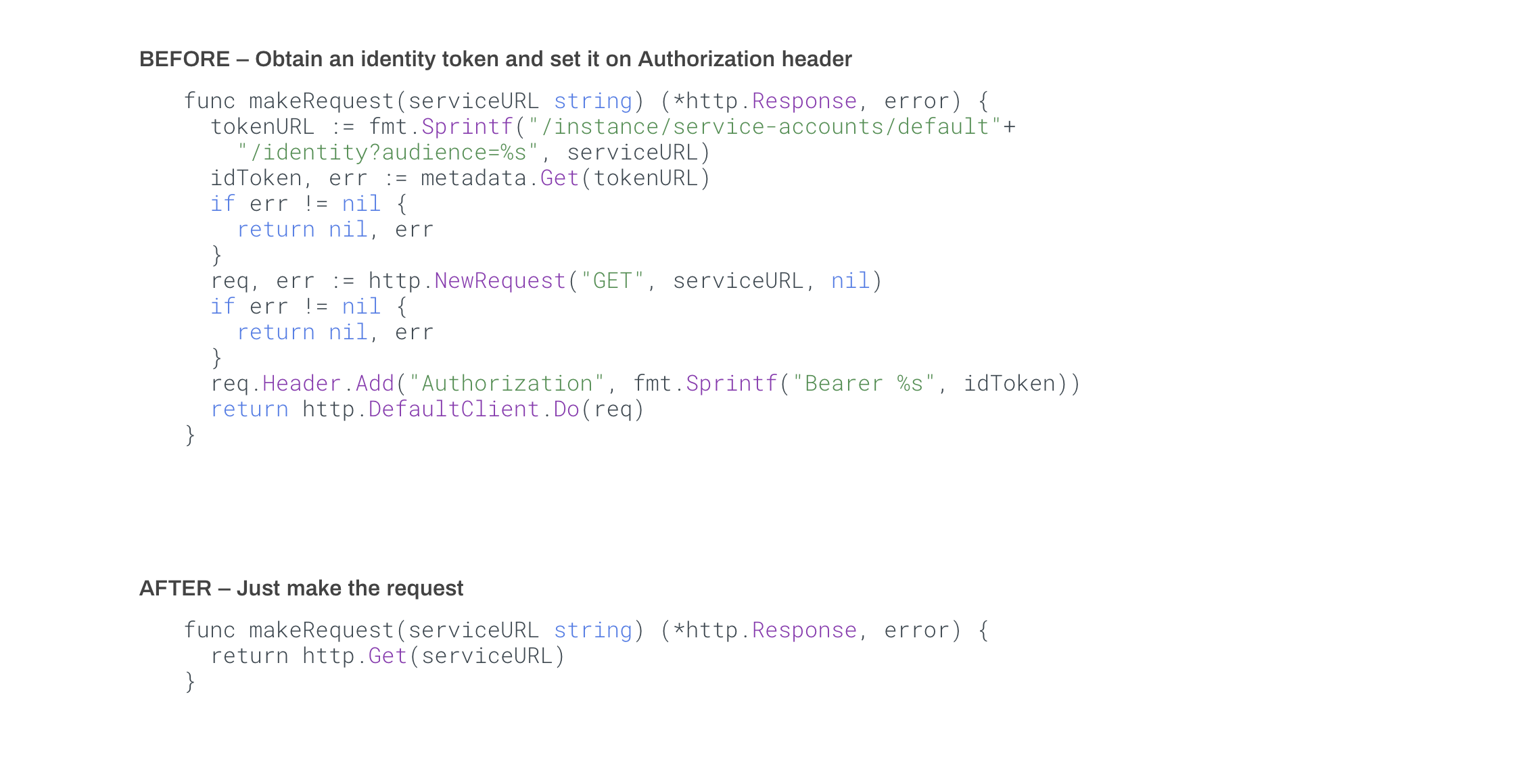runsd is a drop-in binary to your container image that runs on Google Cloud
Run (fully managed) that allows your services to discover
each other and authenticate automatically without needing to change your code.
It helps you bring existing microservices, for example from Kubernetes, to Cloud Run. It’s not language-specific and works with external tools and binaries.
Goal: This tool is developed since Cloud Run does not have built-in service discovery and automatic service-to-service authentication features. The goal is to provide the functionality until the official features ship. It is expected the experience will be quite similar and the migration will be quite easy once the official feature becomes available.
Note: This project is not a support component of Cloud Run. It's developed as a community effort and provided as-is without any guarantees.
runsd does its job in your container, entirely in userspace and does not need
to run with any additional privileges or permissions to work.
With runsd, other Cloud Run services in the same GCP project can be
resolved using hostname http://SERVICE_NAME[.REGION[.run.internal]].
The goal of this project is to provide a solution until Cloud Run has an officially supported feature. Therefore, you should not use the fully qualified domain name format listed above in your code. Only use formats:
http://<SERVICE_NAME>andhttp://<SERVICE_NAME>.<REGION>.
Normally, to have Cloud Run services that make requests to each other (for example, microservices), your program needs to fetch an identity token from the metadata service and set it as a header on the outbound request.
With runsd, this is no longer needed since authentication handled
out-of-the-box. This means you don't need to change your code when you bring
your apps to Cloud Run from other platforms that have name-based DNS resolution
(such as like Kubernetes or Compute Engine):
For my tracking purposes, please fill out the form at https://forms.gle/kCgEEiRqrmHhM65g6 if you are using
runsd. Your feedback will be important in shaping this feature.
To install runsd in your container, you need to download its binary and prefix
your original entrypoint with it.
For example:
ADD https://github.com/ahmetb/runsd/releases/download/<VERSION>/runsd /bin/runsd
RUN chmod +x /bin/runsd
ENTRYPOINT ["runsd", "--", "/app"]
In the example above, change <VERSION> to a version number in the Releases
page. It is wise to pick a version and use it
as long as you can until you hit a bug.
After installing runsd, it will have no effect while running locally. However,
while on Cloud Run, you can now query other services by name over http://.
Note that your traffic is still secure –as the request is upgraded to HTTPS before it leaves your container.
After installing runsd as your new entrypoint, you container
can now make requests to other Cloud Run services in the same project directly
by name, e.g. http://hello.
Note that:
-
You can use
http://helloto connect to a service within the same region. -
You can use
http://hello.us-central1notation if the service is deployed in another region (but the same project). -
Do not use
https://or port443. You need to make requests usinghttpover port80for runsd to work. (HTTPS is added before your request leaves the container.)
You can deploy this sample application to Cloud Run to try out
querying other private Cloud Run services without tokens and without
full .run.app domains by directly using curl.
This sample app has runsd as its entrypoint and it
will show you a form that you can use to query other private Cloud Run
services easily with curl.
Below, replace <HASH> with the random string part of your Cloud Run URLs (e.g.
'dpyb4duzqq' if the URLs for your project are 'foo-dpyb4duzqq-uc.run.app').
gcloud alpha run deploy curl-app --platform=managed
--region=us-central1 --allow-unauthenticated --source=example \
--set-env-vars=CLOUD_RUN_PROJECT_HASH=<HASH>Note: Do not forget to delete this service after you try it out, since it gives unauthenticated access to your private services.
runsd has a rather hacky architecture, but most notably does 4 things:
-
runsdis the new entrypoint of your container, and it runs your original entrypoint as its subprocess. -
runsdupdates/etc/resolv.confof your container with new DNS search domains and sends all DNS queries tolocalhost:53. -
runsdruns a DNS server locally inside your containerlocalhost:53. This resolves internal hostnames to a local proxy server inside the container (localhost:80) and forwards all other domains to the original DNS resolver. -
runsdruns an HTTP proxy server on port80inside the container. This server retrieves identity tokens, adds them to the outgoing requests and upgrades the connection to HTTPS.
By default runsd does not log anything to your application in order to not
confuse you or mess with your log collection setup.
If you need to expose more verbose logs, change the entrypoint in your
Dockerfile from ENTRYPOINT ["runsd", "--", ...] to;
ENTRYPOINT ["runsd", "-v=5", "--", ...]
You can adjust the number based on how much detailed logs you want to see.
If the logs don't help you troubleshoot the issues, feel free to open an issue on this repository; however, don’t have any expectations about when it will be resolved. Patch and more tests are always welcome.
- All names like
http://NAMEwill resolve to a Cloud Run URL even if they don't exist. Therefore, for example, ifhttp://hellodoesn't exist, it will will still be routed to a URL as if it existed, and it will get HTTP 404. - Similar to previous item
http://metadatawill be assumed as a Cloud Run service instead of instance metadata server. To prevent this, use its FQDNmetadata.google.internal.with a trailing dot. - No structured logging support, but this should not impact you since the runsd binary is not supposed to log anything except the errors by default.
- WebSockets, gRPC (incl. streaming) and SSE works. Please file issues if it does not work.
This is not an official Google project.




